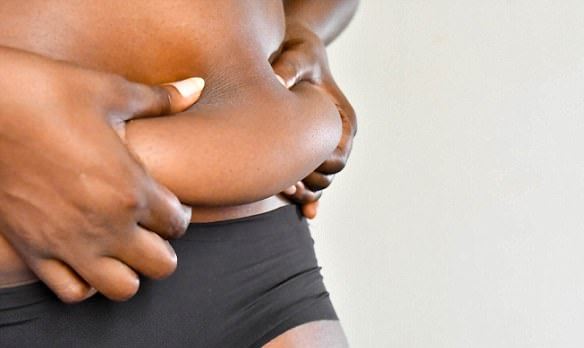Excess body fat is a concern for many people, and is viewed by the majority as unhealthy.
Although obesity has been linked with significant health risks, being overweight doesn’t automatically mean your health is in a bad state. Conversely, many people who are in the healthy range for body weight have some of the health problems typically linked with being overweight, such as diabetes and high blood pressure (source).
In terms of good health, the fat we can see under the skin (subcutaneous fat) is not the biggest problem.
According to research, the kind of fat which is most dangerous to health is the fat stored in the upper body, specifically the abdomen (source). I’m talking about that annoying belly fat here.
Many experts recommend that if you are carrying excess weight around your belly, it is a good idea to come up with a plan to reduce it. In terms of figures, a waistline measurement of over 40 inches in men and over 35 inches in women is a cause for concern.
However, decreasing body fat is not an easy task for most of us. Targeting specific areas of body fat can be even more tricky.
In this article, we have looked into the best ways to reduce belly fat, and investigated the scientific research backing up these methods. Read on to find out some tried and tested ways to lose belly fat.
#1: Reduce Your Sugar Intake
The health risks of consuming large amounts of sugar are well documented.
Too much sugar can cause metabolic dysfunction. This is a health condition where the biochemical processes of the body are disturbed. A high level of sugar in the diet has been proven to cause weight gain and even obesity. It also elevates the risk of diabetes and high blood pressure which increases the risk of cardiovascular disease and stroke.
The liver is particularly affected by sugar consumption. When the liver finds itself inundated with a huge, fast influx of sugar, the consequences can be extremely harmful.
Excess sugar is toxic for the liver, and is converted by the body into fat. The majority of this is stored as belly fat. (source).
Many studies have shown that increased belly and liver fat results in insulin resistance and a whole plethora of other metabolic problems.
When we take in sugar in liquid form, the sugar is digested even more quickly. This results in the liver receiving a massive hit of sugar.
Many of the regular types of soda currently on the market contain large amounts of sugar – check the labels for yourself next time you go shopping.
In addition, these liquid calories don’t help to make us feel full.
A bottle of regular soda, which can contain 50 or more grams of sugar, is easy to drink quickly. Despite its high calorie content, it has little effect when it comes to feeling full (source).
Reducing the amount of sugar in your diet, and in particular avoiding sugary drinks (including fruit juices and sports drinks which contain lots of sugar) will help to limit the sources which are converted into belly fat.
Read packaging labels and take notice of the amount of sugar in food – it is surprising how much sugar some foods contain.
If you have a sweet tooth, get into the habit of turning to whole fruit for your sugar fix. The fiber and water in whole fruit makes the digestion process slower, so does not cause the dramatic sugar hit which is the cause of many health problems, including increased belly fat.
#2: Increase Your Protein Intake
Protein is an important food group in our diets. It provides the building blocks, called amino acids, for the body to be able to renew and repair cells, heal wounds and produce many of the chemicals and hormones the body needs to function.
There is lots of scientific evidence that shows protein is an extremely important contributor in any weight loss program. Some studies suggest that increasing the amount of protein you eat is the absolute best thing you can change in your diet to achieve weight loss.
Eating more protein can reduce craving for other food, potentially reducing calorie intake. It can also boost metabolism, which means the body uses up more calories, leaving fewer calories available to be turned into stored fat (source).
Some research has shown a link between protein and belly fat. Many studies have observed that the more protein in the diet, the less belly fat people have. Much of the research about protein and belly fat suggests that protein intake should account for around 30% of total calories (source).
Foods such as meat, chicken and fish are well-known sources of protein. Other great sources of protein are eggs, seafood, nuts and some whole grains, legumes – for example, peas, beans, chickpeas, lentils and alfalfa – and dairy products.
One way of boosting your protein intake is to consider adding a protein supplement, like whey or pea protein powder, to your diet. It is good to get your protein from a variety of different sources on a regular basis.
#3: Reduce The Amount Of Carbs
There is lots of evidence to prove that a low carb diet is a very effective way to lose weight.
One of the key features of a low carb diet is that it limits the body’s usual primary source of energy – carbohydrates. This forces us to use the next best energy source, which is fat.
So with a low carb diet, most of the weight loss comes directly from stored body fat.
In addition to the huge amount of evidence regarding the efficacy of low carb diets in general weight loss, studies have also shown that low carb diets can help reduce belly fat and the fat which is stored around our vital organs (source).
A low carb diet has the potential to positively affect blood pressure, heart health, our blood glucose levels and the risks associated with diabetes.
A low carb diet can also help to reduce the risk of developing many serious health conditions as well as making our energy levels more consistent throughout the day (source).
A relatively low carbohydrate intake of around 75g per day has been suggested as a good range for a sustainable weight loss program. This would include a large quantity of vegetables, a little fruit and very small amounts of starch-based carbs, like rice.
Carbohydrate sources which should be particularly avoided are foods such as white bread and pasta.
#4: Increase Your Intake Of Fiber
Fiber is one of the most important food groups for good health – in particular, soluble fiber.
Soluble fiber, the type of fiber that absorbs water, helps to reduce cholesterol levels, contributes to weight loss, decreases the risk of heart disease and diabetes, improves bowel function and reduces the symptoms of diverticulitis and constipation (source).
Soluble fiber, when digested, forms a gel-like substance that slows down the digestion of other foods.
This has the effect of making us feel fuller for longer, reduces appetite and helps to avoid large amounts of sugar arriving at the liver in a short amount of time.
We have already seen that this is a situation we need to remedy to achieve good health (source).
In terms of belly fat, some studies have found that a regular intake of 10 grams of soluble fiber reduced abdominal body fat by 3.7%, and observed an even bigger reduction (7.4%) in the abdominal fat of participants who were moderately active (source).
Research has shown that increasing your fiber intake by 14 grams can result in a ten per cent decrease in the amount of calories consumed, and an associated significant weight loss (source).
Fruit and vegetable are great sources of soluble fiber, and in particular, legumes, brussels sprouts, turnips, sweet potatoes, asparagus oranges, grapefruits, mangoes and apricots.
Oatmeal, oat bran, barley and flax seeds are also high in soluble fiber. Fiber supplements are also available on the marker, and worth considering to boost the soluble fiber in your diet.
#5: Change The Oils You Consume
It’s also worth taking note of the oils you use in your diet. Some studies have noted adding 30 ml of coconut oil to your diet helps to reduce belly fat (source).
#6: Exercise Reduces Belly Fat
Firstly, we are not talking about doing mind-bending amounts of particular exercises to target the abdominal area.
Research suggests that targeting particular areas of the body for fat loss is simply not possible, certainly in the case of belly fat (source).
Scientific studies show that the best way to reduce belly fat is large muscle group aerobic exercise, like swimming, walking and running. Because these types of exercise recruit many large muscle groups, they also use a large amount of energy.
The body will first use up the relatively small amounts of energy stored in the muscle, then any other carbohydrate available before starting to mobilize fat stores to use as energy.
One review of research using data from a total of almost 600 participants concluded that exercise at a an activity level 10 times more active than we are at rest, such as brisk walking, light jogging and cycling is effective in reducing belly fat (source).
Exercise has also been proven to be effective in totally avoiding the re-accumulation of abdominal fat following weight loss.
So in addition to all the other health benefits of regular exercise, it can also help you to lose weight, maintain weight loss, reduce belly fat AND help to keep it at bay (source).
#7: Regularly Record And Review Your Diet
It is well documented that we are generally not brilliant at being accurate and objective when considering what we eat every day.
Even if you mentally review what you have consumed in the course of an average day, it’s easy to forget that slice of cake or bar of chocolate.
Okay, it’s a little time-consuming to write down everything you eat, and we’re not suggesting you have to do this every day – in fact, this can have a detrimental effect on your weight loss and fat loss goals. Some people find that it overly focuses their attention on diet and decreases their motivation.
However, once in awhile, it’s a good idea to keep a documented record of your diet over a few consecutive days.
This can help you to see the full picture of your eating habits, highlight problem areas and make the changes you need to increase your chances of a successful eating program.
As an example, three of the most significant changes you can make to your diet to reduce belly fat are to increase your protein intake by the specific amount of 30%, or limit your carbohydrate intake to 75 grams per day, and eat a minimum of 10 grams of soluble fiber per day.
Trying to make these changes without measuring, weighing and recording what you eat is playing a guessing game, and unlikely to yield the best results.
It’s much more effective to accurately measure the intake of these foods, record the information and use it to develop a regular eating plan.
There are lots of tools and apps widely available which can help you record your diet accurately, and these make the task much easier.
Final Thoughts on How to Lose Belly Fat
We have identified a number of reasons why it is important to reduce belly fat for a positive effect on health, and a number of ways in which it is possible to reduce belly fat.
Changing just one thing about your diet or lifestyle is likely to have a beneficial effect, but the most significant health results are likely to be gained from using a combination of factors.
The most beneficial effects are also likely to result from longer term lifestyle changes, so it is very important to make sure the changes you make are sustainable over a long period of time and can be incorporated into your daily life.
Whatever methods you choose to reduce belly fat, with lots of different options available, it’s likely that most people can come up with a plan that works for them.














